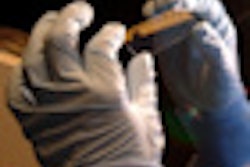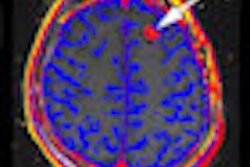BERLIN - Medicine is undergoing a historic transition, moving away from a cookie-cutter model of care and toward individualized treatment strategies based on patient-specific models of disease and treatment. Imaging, biology, and mathematics are at the center of this new paradigm.
"Medicine is in transition because of work that's gone on in fundamental biology," said Dr. Michael Vannier at the opening of the 2009 Computer Assisted Radiology and Surgery (CARS) meeting. "We're at a postgenomic time now, which has enabled us to develop targeted therapies, and so we've seen the emergence of personalized medicine."
Old versus new
The traditional model of care is largely descriptive, said Vannier, a professor of radiology and medicine at the University of Chicago in Illinois. In that model, the physician describes the disease based on few variables and a large sample size. Diagnosis is based on morphology, and treatment is based on the classification of overt disease.
"That type of thinking ... has not served us entirely well, and so changes are at work," he said. In contrast, the new methods are complex and mechanistic, based on multivariate changes in characteristics. Small sample sizes are aggregated by characteristics of genomics, proteomics, metabolomics, and other methods that create smarter groups.
The new paradigm means knowing "much more about an individual and also accumulating and reusing prior experience," Vannier said. Developing these methods, which constitutes a large part of what happens at multidisciplinary meetings such as CARS, can also be called systems biology. The goal of these new methods is to individualize treatment -- and make it as preventive as possible, Vannier said.
These also happen to be the goals of the Personalized Medicine Coalition in the U.S., a coalition of dozens of vendors, provider and patient communities, healthcare payors, researchers, and government entities that aims to advance the personalized care model.
A tectonic shift
"A tectonic shift is taking place in medicine," and the pace of development has accelerated since the mapping of the genome in 2003, Vannier quoted from the organization's Web site. "Personalized medicine may be considered an extension of traditional approaches of understanding and treating disease, but with greater precision."
Ultimately, however, the success of personalized medicine will rise or fall on its ability to demonstrate its value -- to the healthcare system, to the industries that develop its products, and to patients, Vannier said.
There is already evidence of the value of personalized medicine, which promises to:
- Shift the emphasis in medicine from reaction to prevention
- Enable the selection of optimal therapy, and reduce trial-and-error prescribing. "We've developed therapeutic alternatives, and we need some rational basis for sorting them out and choosing the optimal one," Vannier said.
- Make the use of drugs safer by avoiding adverse drug reactions, and revive drugs that are failing in clinical trials or were withdrawn from the market, such as thalidomide
- Increase patient compliance with treatment
- Reduce the time and cost of clinical trials
- Reduce the overall cost of healthcare
"I think it's daunting to realize that many of the therapies that are delivered in the trial-and-error approach to medicine are destined to fail," Vannier said. In 1991, Spear and colleagues reported that pharmacologic therapy fails in 38% of patients taking antidepressants, 40% of those taking asthma drugs, 43% of patients taking diabetes medications, and 75% of those being treated for cancer (Trends in Molecular Medicine, May 2001, Vol. 7:5, pp. 201-204).
So it's clear that therapies that are promising overall are destined to fail frequently in the individual patient, Vannier said. On the plus side, now is a time of extraordinary development, he said.
"It's not just imaging technology or computing technology. We can now genotype an individual for maybe $1,000 ... and that makes it possible for us to use a lot of this in our thinking and decision-making."
This "new biology" can be used to phenotype an individual, and from that information develop mathematical characterizations of physiology, biophysics, and pathophysiologies, he said.
From these types of information, a wide range of clinical applications has already developed, including dose distribution in radiotherapy, image-guided surgery, cardiovascular electrophysiology, vascular tree and perfusion mapping in angiography, and the ability to avoid toxic side effects and maximize the effectiveness of drug therapies.
Of course, the biological models can be incredibly complex, and model selection depends entirely on the particular problem to be solved. But since the status quo is inadequate, it's worth the effort, Vannier said.
"The one-size-fits-all approach is very constraining to us. Treating overt disease at late stages, we eat up a lot of resources but don't deliver much benefit -- we're experts at that in the U.S.," Vannier said. "Prevention is much more efficient and the U.S. rarely invests in it; we have a fee-for-service mentality where we want to deliver more and more services with diminishing benefits."
The new approach relies on systems biology, a concept that emerged with the development of genomics, Vannier said.
Research scientist Mats Jirstrand, Ph.D., defined systems biology as incorporating a new level of subsystems understanding of biological processes and networks.
Systems biology is basically a toolbox that incorporates methods from systems and control theory, computer science, and experimental biology, Vannier said. Its projects are cross-disciplinary and involve biologists, computer scientists, chemists, engineers, mathematicians, and physicists.
Therefore, given sufficient knowledge of the underlying genes, proteins, processes, pathways, and applying computational resources and databases, systems biology is capable of creating forward solutions to problems, he said.
"Turning medicine into a quantitative science is one of the goals for imaging today," Vannier said. "And we do cross-disciplinary projects -- many of us don't have training in a sufficient number of fields to do everything by ourselves."
Systems biology today
Systems biology is like taking real systems and decomposing them into a parts list, and then figuring out how to reconstruct a working system based on all of the available components, he said.
For example, a cardiovascular system might start with the components of proteomics and genomics, and then find a mechanism that allows it to be reduced to a mathematical formula. A model analysis and refinement might follow with the aim of impacting a real system and closing a treatment loop.
"The premise is that if we deliver more precision, the therapy will have a better outcome," he said.
Systems biology methods already in clinical use include conformal therapy, image-guided therapy, and intensity-modulated radiation therapy, which enables higher dose to the tumor. New and more effective drugs such as Gleevec for gastrointestinal stromal tumors and rituximab for lymphoma were developed using a similar approach.
"Those sorts of things prove that the investment in developing this technology has worked out," he said. "And there are new therapies emerging all the time."
Reference databases, such as those that exist for Alzheimer's disease (ADNI), osteoarthritis (OAI), acute stroke (STIR), and oncology (ACRIN/RTOG, caBIG), are another essential component.
Postprocessing imaging studies are used to extract functional maps from multitemporal studies, fuse images from multiple imaging modalities, extract functional maps from multitemporal series, and compare images from multiple patient encounters -- for example, follow-up imaging to determine if a lung nodule has grown.
Decision-support tools -- for example, computer-aided detection -- are then used to identify normal variants and benign conditions, enabling researchers to reuse the experience from prior cases.
Examples of knowledge (and imaging) fusion in use today include the mapping of beams in conformal radiation therapy, and fusing electrocardiology with CT images to plan radiofrequency ablation therapy for atrial fibrillation.
In breast imaging, dynamic contrast MRI, or modeling the uptake of contrast media, enables the precise mapping of abnormalities associated with breast cancer.
Models are used in CT or MRI to determine the benefit of thrombolytic therapy, and SPECT, MRI, and CT are used to determine myocardial viability and the potential for revascularization, Vannier said.
"Developing the model, pinpointing the disease, and using these kinds of models to direct therapy is exceedingly helpful," he said.
The modeling methodologies are intrinsically mathematical, so a broad array of applied mathematics methods are needed for parameter estimation, model reduction, and more.
Experts know to avoid math pitfalls, such as trying to solve NP complete (nondeterministic polynomial time) problems that have remained unsolvable for generations. NP complete problems can often be successfully addressed by substituting approximation algorithms, Vannier said.
Biosystems complexity
"The complexity of biosystems plotted on a temporal and spatial scale basically goes on a continuum from molecular stages all the way to evolutionary processes, organisms, and populations, but many of the mathematical systems are valid in more than one of these areas," he said.
Still, you can't use a model if you don't know how good the model is, Vannier said. Rigorous model validation is needed to determine if the model agrees with the observed data and works for the proposed application. The third system, whether the model reflects the "true" system at work, is impossible to answer, Vannier said.
Personalized medicine is a natural consequence of postgenomic medical science, Vannier said. Systems biology, particularly with the use of imaging, can deliver patient-specific models for many applications.
"Patient-specific models are really central to the strategy of personalized medicine and enable us to realize its benefits," he said.
By Eric Barnes
AuntMinnie.com staff writer
June 26, 2009
Related Reading
PET/MRI breast imaging prototype shows early promise, June 16, 2009
DE-MRI may predict AF treatment outcomes, April 9, 2009
Adenosine stress DECT equivalent to SPECT, MRI, November 21, 2008
CARS report: Imaging workstations key to patient-specific care, June 26, 2008
CARS suite of the future sees key role for image-guided intervention, June 2, 2005
Copyright © 2009 AuntMinnie.com


















